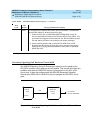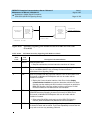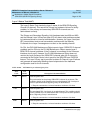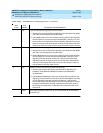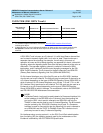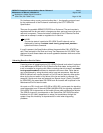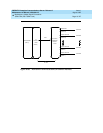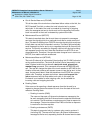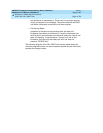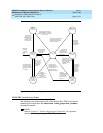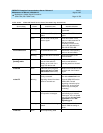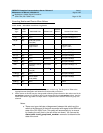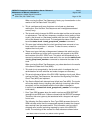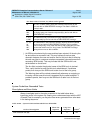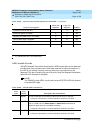
DEFINITY Enterprise Communications Server Release 6
Maintenance for R6vs/si
555-230-127
Issue 1
August 1997
Maintenance Object Repair Procedures
Page 10-749ISDN-TRK (DS1 ISDN Trunk)
10
■ Out-of-Service/Near-end (OOS/NE)
This is the state of the trunk when a hardware failure exists on the link, the
NPE Crosstalk Test fails, or when the trunk is busied out by system
technician. In this state, the trunk is unusable for incoming or outgoing
calls. No messages are sent to the far-end until the signaling link comes
back into service or the trunk is released by system technician.
■ Maintenance/Far-end (MTC/FE)
This state is reached when the far-end does not respond to messages
sent over the signaling link for a particular trunk after a certain amount of
time. This state is different from OOS/FE since the signaling link must have
initially been up and the B-channels in-service. The switch will periodically
send messages to the far-end to try to negotiate the trunk (B-channel) into
service. The trunk is unusable for outgoing calls but will service incoming
call requests from the far-end. Note that transitions into MTC/FE do not
drop stable calls. Therefore, if the service state changes from in-service to
MTC/FE, then stable calls are unaffected.
■ Maintenance/Near-end (MTC/NE)
The trunk (B-channel) is in this state if the signaling link (PI-LINK) is busied
out by system technician. The trunk (B-channel) is also temporarily in this
state if system technician has issued a test trunk trunk_group/trunk_
member long command. This command will execute the ISDN-PRI test
call. This test will change the state of the trunk member to MTC/NE for the
duration of the test unless a call request comes in from the far-end. In that
case, the test would abort. Note that transitions into MTC/NE do not drop
stable calls. Therefore, a system technician- demanded busyout link
lnk-no command will not drop stable trunk calls. In this state, the
B-channel is not usable for new outgoing calls, but is available for
incoming calls and outgoing test calls.
■ Pending States
If the near-end is expecting a timed response from the far-end for a
request to change the service state of a trunk, then the state of the trunk
reflects a Pending State.
— Pending-in-service (PINS)
The near-end has sent a B-channel maintenance message to the
far-end, requesting that the B-channel service state be transitioned
to in-service. The far-end has a certain amount of time to respond to
the message. The service state will be PINS until either a response
is received or the timer expires.
— Pending-maintenance (PMTC)
This state is supported only by systems using country protocol 1
(including US). The near-end has sent a B-channel maintenance
message to the far-end, requesting that the B-channel service state



